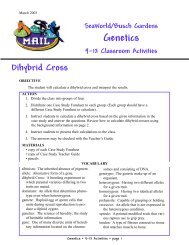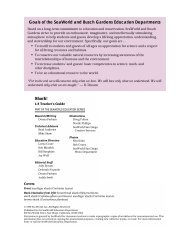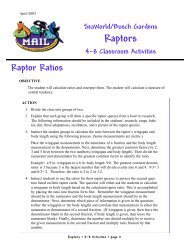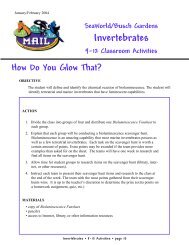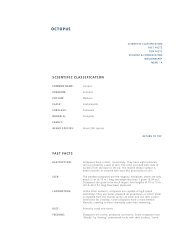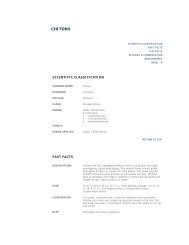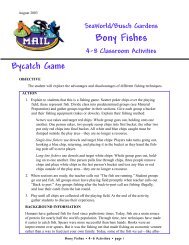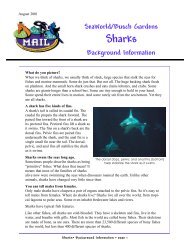Create successful ePaper yourself
Turn your PDF publications into a flip-book with our unique Google optimized e-Paper software.
April 2002<br />
<strong>Gorilla</strong> <strong>Training</strong><br />
OBJECTIVE<br />
OVERVIEW<br />
<strong>Sea</strong><strong>World</strong>/Busch Gardens<br />
Husbandry and <strong>Training</strong><br />
9-12 Classroom Activities<br />
The student will define cognitive learning, behavioral shaping, and operant conditioning. The<br />
student will conduct an experiment using behavioral shaping and record the progress of<br />
cognitive learning<br />
This activity is for students who have a working knowledge of behavior. In this<br />
activity, students will be placed in groups of three. One student will be “observer”,<br />
one will be “trainer”, and one will be the gorilla or “subject.” While the subjects are<br />
out of the room, the trainer and observer will construct an action command using a<br />
dictionary of terms (see Symbol Dictionary provided). When the subject enters, the<br />
trainer and observer will train the subject to complete the action command.<br />
ACTION<br />
1. Divide students into groups of three. Within each group, students choose roles of<br />
observer, subject, or trainer (one in each group).<br />
2. Define cognitive learning as when an animal thinks about something instead of<br />
reacting to a stimulus. Behavioral shaping is a step-by-step process in which incremental<br />
progress is reinforced toward the final goal or terminal response. For example,<br />
a gorilla has been trained to present its finger when you hold you hand up, but<br />
now you would like the gorilla to stand up. To shape behavior, you could slowly<br />
move the target (your hand) higher and higher, making the gorilla stand up in order<br />
to reach your hand.<br />
Define operant conditioning as when an animal learns to operate in its environment<br />
in order to attain reinforcement, in this case, positive reinforcement. Through operant<br />
conditioning, a gorilla can be reinforced for understanding the action command you<br />
have given.<br />
3. After defining these terms, ask the subjects in each group to leave the room. They are<br />
not to have any knowledge of the purpose and nature of this experiment.<br />
4. Explain the trainer’s and observer’s roles. The trainer will train, reward, and test the<br />
subject in the artificial language (see steps for the trainer for exact procedure).<br />
Husbandry and <strong>Training</strong> • 4-8 Activities • page 1
The observer will enforce the no talking policy, assist the trainer in demonstrations to<br />
the subject, monitor the trainer to ensure there is no signaling, and record the results.<br />
5. Remind students there is NO TALKING, POINTING, OR GESTURING during the<br />
activity. Using the Symbol Dictionary, ask the observer and trainer to construct the<br />
action command: “Pick up the fruit.” Each word of the action command corresponds<br />
to a shape in the symbol dictionary. The observer/trainer are to place the corresponding<br />
shapes of the action command on the table. The fruit should also be available.<br />
6. Allow the subjects to enter the room and sit across from an observer/trainer team.<br />
7. The observer should record all training methods used and the results. The observer<br />
should note the sentence, how the trainer tried to teach the sentence, if the subject<br />
responded and how, and problems the subject and trainer encountered. Later, all students<br />
will write a brief report about this activity depending on their perspective.<br />
8. The trainer and observer should also use the following symbols to communicate with<br />
each other as not to speak during the session.<br />
repeat the action: hold up two fingers<br />
do not use cueing: hand on top of head<br />
stop the session/action: hand at throat<br />
*******Suggested steps for the trainer during the training session:<br />
1. Place the representative symbols for “Pick up the fruit” on the table or desk before<br />
your subject enters the room.<br />
2. Place a pile of M&Ms by the subject. If they attempt to take one, gently remove their<br />
hand. The M&Ms are used to reinforce the subject's correct answers and must be<br />
earned.<br />
3. Teach the symbol for fruit by handing the subject the correct symbol for the fruit,<br />
then by taking it away and placing the fruit in their hand. This will allow the subject<br />
to correlate the shape with the fruit.<br />
4. Remove the fruit from their hand and lay it aside. Repeat this exercise with the<br />
observer while the subject watches. The observer should then demonstrate what the<br />
action command tells them to do. Trainer should then reward observer with an<br />
M&M.<br />
5. For every incorrect action, take away and M&M from their pile. When correct,<br />
reward them with an M&M in their hand.<br />
6. Try different training techniques until subject understands. Repeat for each new sentence<br />
(from the Symbol Dictionary).<br />
(Note: This is just one method for training this command. Students may choose<br />
another options to train the subject while staying within the experiment's rules.)<br />
Husbandry and <strong>Training</strong>• 9-12 Activities • page 2
BACKGROUND INFORMATION<br />
David Premack, a well-known behavioralist<br />
conducted studies of language<br />
acquisition and cognitive abilities in<br />
chimpanzees using simple plastic symbols<br />
to represent words. Rewarding<br />
correct responses with treats, he used<br />
behavioral shaping to teach subjects<br />
associations between symbols and<br />
objects or concepts and actions.<br />
Teaching symbolic language is very<br />
difficult without a shared language<br />
such as English. These studies help<br />
scientists to understand how animal<br />
minds work, which is helpful in understanding<br />
many other components about<br />
animal life.<br />
MATERIALS<br />
Wild gorillas are difficult to study because<br />
they are shy, secretive inhabitants of<br />
densely vegetated tropical forests.<br />
For each trainer/observer team:<br />
• copy of blank Symbol Dictionary<br />
• completed Symbol Dictionary<br />
• 2 pencils<br />
• 1 medium bag of M&Ms<br />
• a piece of banana, apple, or other fruit<br />
• Observation Records sheet<br />
• construction paper and scissors<br />
Prep<br />
Cut the nine designated shapes (as shown<br />
on the Symbol Dictionary) from construction<br />
paper. Cut enough so that each<br />
group has one set.<br />
Husbandry and <strong>Training</strong> • 9-12 Activities • page 3 © 2002 Busch Gardens .
Symbol Dictionary<br />
1. PICK FRUIT UP<br />
2. TAKE FRUIT<br />
3. GIVE FRUIT TO TRAINER<br />
4. TAKE FRUIT AND GIVE<br />
TO TRAINER<br />
Husbandry and <strong>Training</strong> • 9-12 Activities • page 4 © 2002 Busch Gardens .
Recorded Observations Worksheet<br />
SAMPLE:PICK FRUIT UP.<br />
Method: Pointed to fruit, then trainer picked up fruit. After completed behavior, trainer<br />
took an M&M.<br />
Correct Attempts Incorrect Attempts<br />
II IIII<br />
Time Length: 35 minutes (from the beginning of training to when the subject understood<br />
the symbol sentence.)<br />
Observer Notes:<br />
Subject was confused until trainer showed by example. Trainer then gave subject M&M<br />
when subject seemed to begin to grasp the idea. Subject responded well to reinforcement<br />
of M&M.<br />
1. PICK FRUIT UP.<br />
Method:<br />
_____________________________________________________________________<br />
_____________________________________________________________________<br />
Correct Attempts Incorrect Attempts<br />
Time Length:<br />
_____________________________________________________________________<br />
Observer Notes:<br />
_____________________________________________________________________<br />
_____________________________________________________________________<br />
_____________________________________________________________________<br />
_____________________________________________________________________<br />
2. TAKE FRUIT.<br />
Method:<br />
_____________________________________________________________________<br />
_____________________________________________________________________<br />
Correct Attempts Incorrect Attempts<br />
Time Length:<br />
_____________________________________________________________________<br />
Husbandry and <strong>Training</strong> • 9-12 Activities • page 5 © 2002 Busch
Observer Notes:<br />
_____________________________________________________________________<br />
_____________________________________________________________________<br />
_____________________________________________________________________<br />
_____________________________________________________________________<br />
3. GIVE FRUIT TO TRAINER.<br />
Method:<br />
_____________________________________________________________________<br />
_____________________________________________________________________<br />
Correct Attempts Incorrect Attempts<br />
Time Length:<br />
_____________________________________________________________________<br />
Observer Notes:<br />
_____________________________________________________________________<br />
_____________________________________________________________________<br />
_____________________________________________________________________<br />
_____________________________________________________________________<br />
4. TAKE FRUIT AND GIVE TO TRAINER.<br />
Method:<br />
_____________________________________________________________________<br />
_____________________________________________________________________<br />
Correct Attempts Incorrect Attempts<br />
Time Length:<br />
_____________________________________________________________________<br />
Observer Notes:<br />
_____________________________________________________________________<br />
_____________________________________________________________________<br />
_____________________________________________________________________<br />
_____________________________________________________________________<br />
Husbandry and <strong>Training</strong>• 9-12 Activities • page 6






